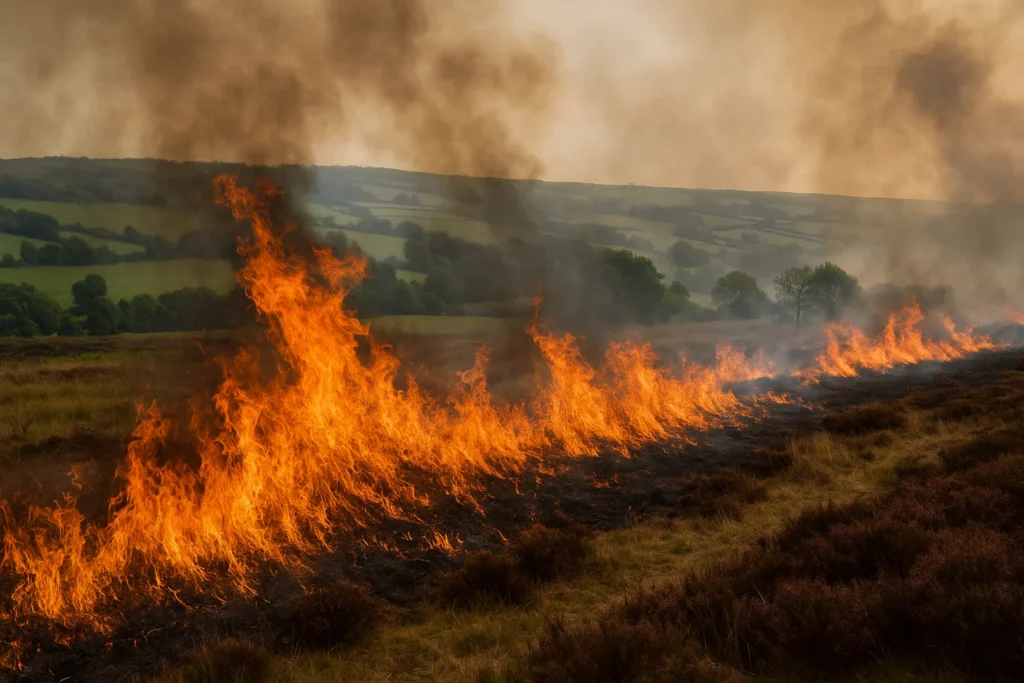Prologue: The Day the Moors Caught Fire
Fire Chief Emma Carter coughed into her sleeve as embers rained down on the Bronte Parsonage Museum. Just hours earlier, her crew had been containing a routine grass fire near Haworth’s famous literary landmark. Now the entire valley glowed orange, with flames leaping 30 feet into the air as century-old peat ignited beneath their boots.
“This isn’t supposed to happen here,” she radioed to headquarters, her voice cracking. “Not like this. Not in May.”
Yet by mid-May 2025, Britain had already shattered its wildfire records—163 significant blazes scorching landscapes from the Scottish Highlands to the Cornish cliffs. The fires weren’t just breaking records; they were rewriting the very identity of a nation that prided itself on its damp, temperate climate.
Chapter 1: The Numbers Behind the Crisis
2025 By the Alarming Numbers
✔ 163 major wildfires (surpassing the previous annual record of 135 set in 2022)
✔ 27,000+ acres burned (equivalent to the entire city of Manchester)
✔ 40% increase in fire service callouts since 2020
✔ £300 million+ in estimated damages (and rising)
Regional Breakdown: Where Britain Burns
| Region | Acres Burned | Notable Impacts |
|---|---|---|
| North York Moors | 8,200 | Ancient peatlands releasing centuries of stored carbon |
| Dartmoor | 5,600 | Rare habitats for ground-nesting birds destroyed |
| Scottish Highlands | 3,800 | First-ever major wildfires in traditional “wet zones” |
| Lake District | 2,400 | Tourism industry devastated during peak season |
Chapter 2: The Perfect Firestorm
Climate Change as Catalyst
- Driest April in 150 years (63% less rainfall than average)
- Record spring temperatures (22°C average vs. 14°C norm)
- Vanishing dew points (reduced overnight moisture recovery)
- Stronger, drier winds fanning flames unpredictably
Human-Made Vulnerabilities
- Land Management Shifts
- 60% reduction in sheep grazing since 2000 → overgrown brush
- Commercial forestry favoring flammable conifer species
- Abandoned farmland becoming tinderboxes
- Cultural Blind Spots
- No national wildfire warning system until 2023
- Fire services still equipped primarily for structure fires
- Public perception of UK as “too wet to burn”
“We’ve spent 300 years draining wetlands and planting fire-prone species. Now climate change has lit the match.”
— Prof. Alistair Heath, Wildfire Ecologist at Leeds University
Chapter 3: Voices from the Firelines
Firefighter’s Journal (Dartmoor Frontlines)
“Day 14: The peat won’t stop burning. We dump water and it just hisses, then reignites hours later. The smoke gets in your teeth. The museum volunteers keep bringing us tea like we’re at a village fete while their world burns.”
Farmer’s Testimony (North Yorkshire)
“My family has worked this land since Victoria was queen. Those hedgerows my great-grandfather planted? Gone in minutes. The fire moved faster than sheep can run. We lost ewes that had lambed just days before.”
Ecologist’s Field Notes (Cairngorms)
“The golden plover nests are all ash now. That population might never recover. The scary part? This was just a Category 2 fire. What happens when we get a Category 5?”
Chapter 4: Cascading Consequences
Environmental Fallout
- Carbon Time Bomb: Peat fires release 500+ years of stored CO₂
- Biodiversity Collapse: Rare species like curlews and adders losing habitats
- Water Contamination: Ash runoff poisoning rivers and reservoirs
Economic Shockwaves
- Tourism Industry: 45% cancellation rate in Lake District bookings
- Agriculture: £87 million in lost livestock and crops
- Insurance Sector: Premiums up 200% for rural properties
Cultural Trauma
- Heritage Sites: Bronte manuscripts narrowly saved in Haworth
- Community Fractures: Blame games between landowners and agencies
- Generational Shifts: Young farmers reconsidering rural futures
Chapter 5: Fighting Back
Innovative Solutions Emerging
- AI Fire Prediction: University of Edinburgh modeling fire spread patterns
- Drone Fleets: Thermal imaging to detect peat reignition
- Ancient Wisdom Revival: Reintroducing controlled burns and grazing
Policy Changes Needed
- National Fire Risk Rating System (modeled after Australia)
- Dedicated Wildfire Brigade (currently only 3 specialist units exist)
- Land Use Reform: Incentives for fire-resistant landscaping
Epilogue: The New Normal
As climate models predict 50% more fire-risk days by 2030, Britain faces an existential question: Can it adapt fast enough to protect both its landscapes and its identity? The alternative—a country where “green and pleasant land” becomes “scorched earth”—is no longer unthinkable.
Is Britain doing enough to prepare for its fiery future? Or are we still clinging to outdated ideas of a ‘damp island nation’? 🔥🇬🇧



